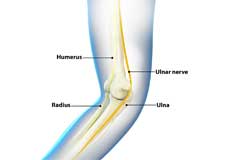

Several predictive factors for prolonged RTW after CTR have been identified, including manual labour, depression, and bilateral surgery 6, 9, 10.

The definition of return to work may vary among studies, comprising both return to part time work or return to work with modified work duties. The sick leave pattern and time to RTW after surgery for UNE has not been studied as thoroughly as RTW after carpal tunnel release (CTR), traumatic ulnar nerve injuries or severe hand trauma 6, 7, 8. How this reform of the social insurance system affected the pattern of sick leave and RTW in various hand disorders has not previously been highlighted. Additional information regarding the social insurance system and the rehabilitation chain is presented in Table 1. The reform resulted in more stringent rules for the right to sickness benefit, and rejections became more common in cases of longer periods of sick leave. The Swedish Social Insurance Agency reformed the social insurance system in 2008, because of parliamentary decisions, introducing a so-called rehabilitation chain 4, 5. Permanent sickness benefit can be paid if a person, aged 19–64 years, affected by disease, trauma, or disability, is judged to be currently or permanently unable to work 3. Unemployed people also receive sickness benefit. For those in employment, the employer pays the first 14 days of sick pay, after which the Swedish Social Insurance Agency pays sickness benefit. This is required if the sickness period exceeds seven days. In Sweden, the right to medical insurance compensation during sick leave, called sickness benefit, is dependent on a sickness certificate issued by the treating physician. Surgically treated patients may not immediately return to work (RTW) after surgery, depending on the patient’s work tasks, since the operated arm needs to heal and functionally recover. Two entities of this condition, entrapment beneath the humeroulnar aponeurotic arcade and external compression of the ulnar nerve in the retroepicondylar groove, have been identified, comprising patient groups with varied preoperative characteristics and type of work 2. Ulnar nerve compression at the elbow (UNE) is the second most common peripheral entrapment neuropathy in the upper extremity and most often affects people of working age 1. In conclusion, unemployment, younger age at surgery, manual labour, transposition, and revision surgery were related to prolonged RTW. Comparisons before and after 2008 showed occupational differences and differences in RTW, where cases operated before 2008 more often had permanent sickness benefit, but the reform of the social insurance system did not seem to influence RTW. Prolonged RTW was approximately four times more likely after transposition than after simple decompression. Prolonged RTW was seen among younger, manual workers and after transposition or revision surgery.

A sub-analysis of the exact number of weeks before RTW (n = 201) revealed longer RTW for unemployed cases compared to employed cases. Surgically treated cases of UNE (n = 635) from two time periods (2004–20–2014) and two healthcare regions (Southern and South-eastern) were studied retrospectively regarding age, sex, comorbidities, occupation, type of surgery and time to RTW. We aimed to examine RTW postoperatively for UNE, variations among surgical methods, and potential risk factors for prolonged RTW (sick leave > 6 weeks). In 2008, the Swedish Social Insurance Agency reformed the national insurance policy. Surgically treated patients may not immediately return to work (RTW) postoperatively. Ulnar nerve compression at the elbow (UNE) frequently affects people of working age.


 0 kommentar(er)
0 kommentar(er)
